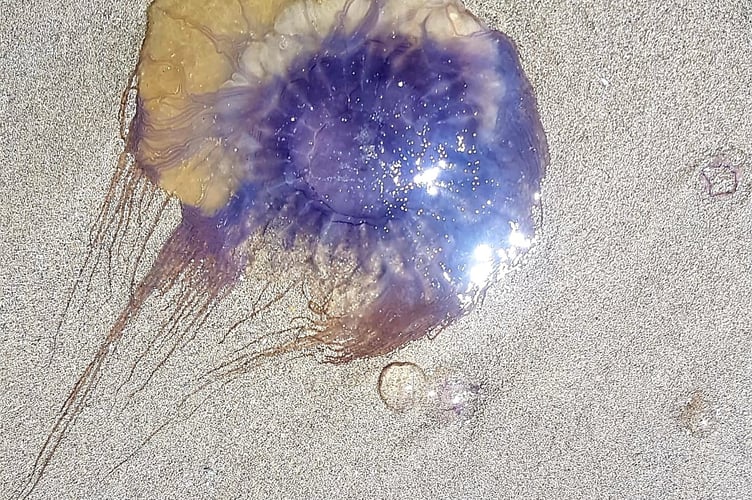An amazing array of jellyfish are washing up on Cardigan Bay shores – including a monster in Fairbourne and venomous visitors from Portugal.
As temperatures rise ahead of midsummer, hundreds of mysterious alien-like creatures patrol the waters and strike fear into the hearts of would-be swimmers.
There are several species of jellyfish you can easily see this time of year if you’re a resident or visitor to Cardigan Bay.
One such species is the aptly named Barrell Jellyfish which can grow to gigantic sizes, like one found washed up on Fairbourne beach in Gwynedd last week.
It was said to measure at least a metre in length and prompted a social media frenzy due to its size – with people describing it as a ‘monster’ and one person asking if it was photoshopped.
But a kayaker from Borth warned that if you venture out to sea far enough from the beach during May and June, you can see tens of Barrel Jellyfish that are about that size.

Sometimes referred to as a dust-bin lid jellyfish, they can deliver a mild sting, but are considered harmless.
It is usually smaller jellyfish that pose more of a threat to humans.
The smaller Compass and Mauve Stinger jellyfish – which light up when threatened – will also sting if swimmers get too close.
The Blue Jellyfish, which is rarely seen in Cardigan Bay and has long purple tentacles, can deliver a more painful sting but it is said to be akin to a nettle sting.

The largest is the Lion’s Mane Jellyfish, less common along the Welsh coastline, which also delivers a powerful sting – with any unfortunate victim advised to consult a doctor if swelling occurs.
Some Borth beachgoers claim to have had usually rare encounters with Portuguese Men of War recently, which are famed for their highly venomous stings. They are not actually jellyfish but a colony of organisms working together. They are usually a mixture of blue, purple or pink in colour, with an air-filled bag which floats on the surface and very long tentacles.
Their sting can be very painful and, in some cases, fatal.

Other species such as the distinctive Moon Jellyfish – about the size of a dinner plate – pose no threat to humans and are capable of only a mild sting.
Social media users have posted pictures of sea gooseberries in the last week which are classed as a comb jelly and only measure about a centimetre across – but can cause irridescence in the water.
Scientists have reacted to speculation that foul-smelling algal bloom – mistaken by some as sewage discharge, as the Cambrian News reported – is attracting the strange animals to shores along Cardigan Bay.

Environment group Way of the Wild said: "It’s that wonderful time of year again when lots of these beasties turn up in our waters.
“But don’t freak out, a little bit of knowledge about the different types and whether they sting or not can go a long way to helping everyone appreciate the beauty of these creatures.
“Jellyfish are mesmerising to watch pulsing through the water. They are 95 per cent water, and have no brain, blood, or heart.
“They don’t have eyes, but they can sense light. Some sting and some don’t, so if you can tell them apart there’s no need to be afraid.”
The Way of the Wild group urges people to report their jellyfish sightings to the Marine Conservation Society at www.mcsuk.org
It also says urinating on jellyfish stings doesn’t work and is a myth – and said for treatment of jellyfish stings find NHS advice at https://www.nhs.uk/.../jellyfish-and-other-sea-creature.../





Comments
This article has no comments yet. Be the first to leave a comment.